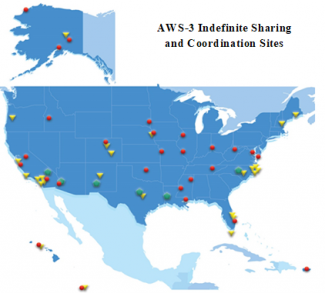Newsroom
Use the filters below to narrow publications by offices, programs or categories

The Trump administration has made substantial progress in improving the resilience of the Internet ecosystem and reducing the threat of botnets. In a report released today, the Departments of Commerce and Homeland Security documented more than 50 activities led by industry and government that demonstrate progress in the drive to counter botnet threats.
NTIA launched the Minority Broadband Initiative (MBI) in November 2019 in partnership with Historically Black Colleges and Universities (HBCUs) and Tribal Colleges and Universities (TCUs) to work on solving deployment challenges in vulnerable communities.
NTIA’s National Broadband Availability Map (NBAM) has added Indiana and Georgia to its growing roster of participants. These additions closely follow the incorporation of Wyoming and Washington State to the broadband platform earlier this month. To date, NBAM includes 22 states.
NTIA’s National Broadband Availability Map (NBAM) reached a 20 state milestone with the addition of Wyoming and Washington State.
Today, NTIA is announcing the establishment of the Communications Supply Chain Risk Information Partnership (C-SCRIP), a program to share supply chain security risk information with trusted communications providers and suppliers.
The Minority Broadband Initiative (MBI) has been closely engaging with Historically Black Colleges and University (HBCU) presidents, chancellors, and students on Digital Economy related issues since its launch last November. Building and maintaining conversations with key stakeholders has been instrumental in understanding and exploring options for leveraging HBCU broadband infrastructure to connect neighboring communities of vulnerable populations, especially during the outbreak of COVID-19.
By NTIA
NTIA today is announcing the addition of five states to its National Broadband Availability Map (NBAM) program. Wisconsin, Colorado, Illinois, Oregon, and New Hampshire join 13 other states who are partnering on this critical broadband data platform.
NTIA has updated its BroadbandUSA website database of 57 federal broadband programs, spanning 14 federal agencies with billions of dollars for broadband grants, loans, and other resources.
The Trump Administration is poised to make significant progress this year in efforts to promote new 5G opportunities through mid-band spectrum sharing. In January, NTIA reported considerable potential for spectrum sharing options in the 3450-3550 MHz band.
Broadband is more important than ever, and the National Telecommunications and Information Administration (NTIA) has been working to expand access and increase connectivity for all Americans.
Federal agencies have made significant progress across government to improve broadband access for Americans in the year following the launch of the American Broadband Initiative (ABI), said speakers in a recent NTIA BroadbandUSA webinar.
This year’s International Symposium on Advanced Radio Technology (ISART) conference will take place Aug. 11-13 in Boulder, Colorado. The conference will focus on what a “zero trust” network environment means from a 5G perspective. The symposium, which is co-sponsored by NTIA and the National Institute of Standards and Technology, will include panel discussions, presentations, tutorials, and demonstrations from subject matter experts from U.S. and international organizations. Visit the ISART website for more information.
NTIA’s State Broadband Leaders Network is a powerful forum for connecting local government, industry and stakeholders across the country that are focused on broadband activities. NTIA has spent many years building up these relationships, and recently updated our website with detailed information on state broadband offices and funding opportunities.
America’s technology leadership in secure and reliable 5G communications is critical to the nation’s economic and international competitiveness. Delivering on these goals, President Trump’s Fiscal Year 2021 budget calls for increased funding to modernize the nation’s spectrum management system; improve the security of our telecommunications infrastructure; and upgrade advanced communications research.
Spectrum sharing strategies hold great promise for meeting the growing needs of commercial and federal users. This is an area of intense study at NTIA as we seek to protect critical federal missions while enabling new commercial opportunities.
As we close the books on 2019, NTIA took stock of strides made in the past year on key Administration priorities. Topping the list is our work to make spectrum available for 5G, including completing engineering work to put critical mid-band spectrum to use in the 3.5 GHz band. NTIA also is proud of our work with government partners to enhance broadband connectivity, improve technology equipment in 911 call centers, and secure networks from cyber threats.
Ensuring U.S. Leadership in 5G, Broadband Opportunities
Participants in NTIA’s software security multistakeholder effort made significant progress this year, publishing the first set of community-drafted documents to offer guidance around the practice of a software bill of materials (SBOM). The SBOM functions as a “list of ingredients” for software that can help organizations keep track of the underlying components that make up almost all software today.
Every initiative to expand spectrum use and efficiency relies on predictions of how far a wireless signal will travel, or propagate, before interfering with another user or fading away. Unlocking the full potential of spectrum resources requires a deep understanding of radio wave behavior, and accurate propagation models, so that systems can be designed to coexist in a crowded environment.
One of the most significant challenges to expanding broadband connectivity is determining which parts of the country remain unconnected. Getting this information would help states and local communities – and the providers they work with -- more accurately understand where new infrastructure is needed.
Earlier this month, NTIA convened the latest in a series of multistakeholder meetings on software component transparency. For more than a year, stakeholders have been exploring this issue through four working groups established during the July 2018 kickoff meeting. The broader community meets periodically to share progress and encourage feedback through in-person and virtual meetings.
